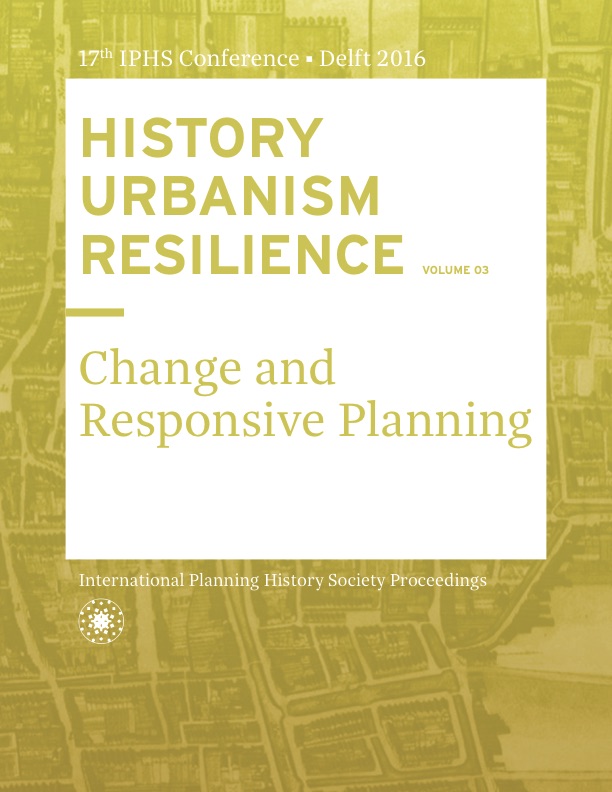EARTHQUAKE AND RESILIENCE POLARIZATIONS ABOUT MODERN PLANNING IN CHILE
DOI:
https://doi.org/10.7480/iphs.2016.3.1269Abstract
The paper poses the question about the planning modernization processes happened in Latin America, and about the role that disasters, and specifically earthquakes, played within them. In the case of Chile, earthquakes have been present all along its history. During the 20th century, some of them have been significant factors in the development of modernization process: Valparaíso, 1906, Talca 1928, among others. What kind of discussion about urban modernization did those disasters open, and how was modern planning perceived within them?The proposed hypothesis suggests that resilience, developed as a cultural feature, after a long exposure to earthquakes and others disasters, not only promotes the reconstruction processes, but also offers the opportunity to discuss urban models and paradigms. Following the way in which Schumpeter and others have put it (creative destruction), reconstruction processes have been occasions to promote already existing urban agendas or introduce new concepts, methods and paradigms.
The Chillán earthquake, happened in Chile in January 1939, is proposed as an study case to examine those processes. The earthquake coincided with a political crises, involving social, economical and cultural dimensions. The reconstruction of Chillán and other cities in the region, opened a big discussion among local planners. This surpassed the technical domain and permeated into the media and the public opinion.
The two main struggling forces were those of Karl Brunner disciples and Le Corbusier partisans. Both considered themselves as modern planning representatives, but conceiving this in very different ways. Karl Brunner (1887-1960) had visited Chile in 1929 and 1932. He delivered the first Latin American planning seminar at Universidad de Chile and did urban plans for the government and Santiago Municipality. He had set an agenda for urban modernization in the country, which had been developed by his disciples in the following years. Le Corbusier (1887-1965) on his side, had visited some Latin American countries (Brazil, Argentina, Uruguay and Paraguay)in 1929, while Brunner was working in Chile. After the Chillán earthquake, a group of architects invited Le Corbusier to visit the country and have a leading role in the reconstruction process. Brunner disciples strongly opposed the idea, detonating a public controversy about the nature of modern planning.
The paper suggests that this local discussion reflected tensions that went far beyond the local realm. They had to do with different conceptions about modernization processes and urban planning renovation. At the same time, this polarization, taking place within the experts’ realm, reflected a wider dispute about Latin America as a possible professional field for European or North American planners.
References
Almandoz, Arturo. Planning Latin America’s Capitals Cities 1850, 1950. London: Routledge, 2002.
Bannen, Pedro, Perez, Fernando and Vazquez, Claudio. “Entendidos, Subentendidos y Malentendidos sobre el Urbanismo Moderno: Alternativas del Frustrado Viaje de Le Corbusier a Chile,” in Massilia 2003. Anuario de Estudios Lecorbusierianos 130-151. Barcelona: Fundación Caja de Arquitectos, 2003.
Berman, Marshall. All that is Solid Melts into Air. New York: Penguin Books, 1982.
Brunner, Karl H. Weisungen der Vogelschau, Flugbilder aus Deutschland und Österreich un iher Lehre für Kultur, Siedlung und Städtebau. München: G.D.W. Callwey, 1928.
Brunner, Karl H. Manual de Urbanismo. Bogotá: Consejo Municiapl de Bogotá, 1939.
Carvajal, David. Institucionalidad Nacional y la Catástrofe de Chillán. La Corporación de Reconstrucción y Auxilio en la reconstrucción de Chillán (1939), Master Thesis. Santiago: Instituto Estudios Urbanos Pontificia Universidad Católica de Chile, 2011.
Cerda, Alejandro. El Surgimiento de la Arquitectura Moderna en Chillán Después del Terremoto de 1939. Chillán: Universidad del Bío-Bío, I. Municipalidad de Chillán,1990.
Collier, Simon and Sater William. Historia de Chile 1808-1994. Madrid: Cambridge University Press 1999.
Crispiani, Alejandro and Errázuriz, Tomás. (2013). “La Reaparición de lo Público. Experiencias de Habitación Durante el Posterremoto”. Revista 180, nº31, 2013: 16-21.
Davoudi, Simin. “Resilience: A Bridging Concept or a Dead End?”. Planning Theory & Practice 13, nº2, 2012: 299-307.
Frampton Kenneth, Modern Architecture a Critical History. London: Thames and Hudson, Fourth Edition, 2007.
Guarda, Gabriel. Historia Urbana del Reino de Chile. Santiago de Chile: Andrés Bello, 1978.
Hofer Andreas. Karl Brunner y el Urbanismo Europeo en América Latina. Bogotá: El Ancora Editores, 2003.
Hofer Andreas. “The Latin American City and its Viennese Planning Approach: Karl Brunner in Chile and Colombia 1929-1948,” in Sitte, Hegemann and the Metropolis, Modern Civic Art and International Exchange, ed. Bohl, Charles and Lejeune, Jean François. London and New York: Routledge, 2009.
Le Corbusier. Vers une Architecture. Paris: Les Editions G. Crés et Cie., 1923.
Le Corbusier. Précisions sur un état présent de l’architecture et de l’urbanisme. Paris: Les Éditions G. Crés et Cie., 1930.
Moos, Stanislaus von. Le Corbusier. Barcelona: Lumen, 1977.
Mumford, Eric.The CIAM Discourse on Urbanism. Cambridge Massachusetts, London: The MIT Press, 2000.
Paez. Pablo. La oportunidad de la Destrucción en la Urbanística Moderna. Planes y Proyectos para la Reconstrucción de Valparaíso tras el Terremoto de 1906. Master Thesis. Santiago de Chile: Pontificia Universidad Católica de Chile, Instituto de Estudios Urbanos y Territoriales, 2008.
Pavez, María Isabel. La Institución del Urbanismo en la Facultad de Arquitectura y Urbanismo de la Univerisdad de Chile 1928-1988. Santiago: Universidad de Chile, facultad de Arquitectura y Urbanismo 1992.
Pavez, María Isabel. Arquitecto Luis Muñoz Maluschka, Planificador Territorial en Chile. Santiago: Facultad de Arquitectura y Urbanismo Universidad de Chile 2012.
Perez, Fernando, Sánchez Yunleng, “Relaciones de Le Corbusier y Sudamérica,” in Le Corbusier y Sudamérica Viajes y Proyecto, ed. Pérez Fernando. Santiago de Chile: ARQ, 1991
Recuerdos del Terremoto del 16 de Agosto de 1906 (Memories of the Earthquake of the 16thAugust 1906) (c 1907).
Rodriguez dos Santos, Cecilia, da Silva Pereira, Romao Veriano, da Silva Pereira, Margareth and Caldeira da Silva, Vasco “El Viaje del 36” in Le Corbusier y Sud-América Viajes y Proyectos, ed. Fernando Pérez. Santiago de Chile: ARQ, 1991, 42-49.
Schumpeter, Joseph. Capitalism socialism and democracy. New York: Harper, c1950

